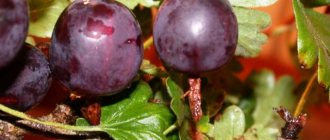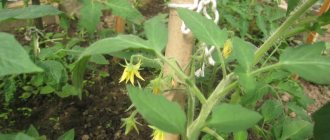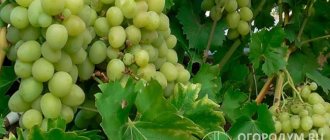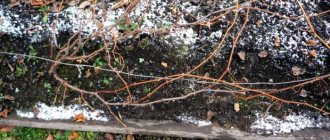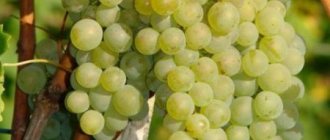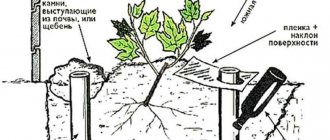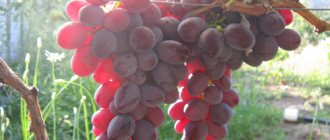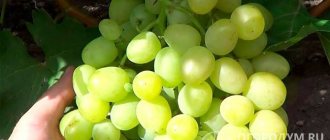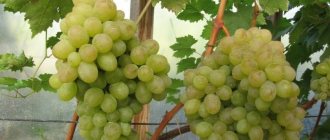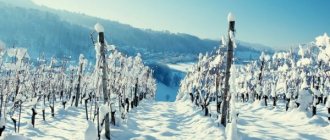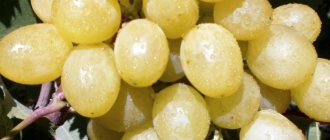Northern shoulder is one of the oldest grape varieties, used mainly for making wine (for tableware purposes). The origin of the variety is unknown; many sources say that the first bushes were planted several centuries ago on the Black Sea coast of Russia.
The variety is called a favorite of winemakers; it continues to be grown, despite some shortcomings.
Characteristics and features of the variety
Northern shoulder grapes are grown as a non-covered crop in the Central, Southern, and Northwestern regions, as well as in the Far East and Siberia.
The variety can withstand frosts up to 32 degrees, without any losses. Resistance to diseases and pests is relatively low. The ripening period is average, the period from the appearance of buds to harvest takes no more than 140 days. Depending on the region, this is mid-August - early September. The berries that ripen first fall off. Attention!
The variety has several other names - Goryun, because it looks like a mountain, Letun and Osypnyak (some of the ripe berries fall off), Black Wine, because of the color of the berries. The variety was nicknamed "Shoulder" and "Horned Brush" for the shape of the bunches.
Description of the plant
The bush is vigorous and requires reliable, strong support. The leaves are round, slightly elongated, strongly dissected, divided into 5 lobes, dark green. On the upper side the plate is decorated with a mesh of a contrasting, lighter shade; on the reverse side and on the veins there is a thick fluff. The branches are strong and flexible.
The brush is medium-sized (up to 300 grams), conical or cylindrical with pronounced shoulders; individual clusters can gain weight up to 1.5 kilograms. The berries are up to 3 grams, dark blue, almost black with a bluish waxy coating, round in shape with a slightly flattened top. The taste is sweet, the aroma is unobtrusive, grape without impurities. The juice yield is up to 86%, it contains 23% sugar and no more than 9 grams of acids. The pulp is juicy, tender, there are a lot of seeds, the skin is thin, almost imperceptible.
Productivity and use of berries
The berries are universal in use, suitable for making desserts, juices, compotes, and assorted fruits. As a technical grape, Northern shoulder is used for the production of balms, sparkling and regular wines, as well as for strong alcoholic drinks. The yield is stable, an adult bush produces approximately 10 kilograms of berries.
Frost-resistant grapes Northern Pleschistik - a favorite of winemakers
Northern Plechistik is one of the very old, perhaps even ancient, grape varieties that were originally grown on the Don. It owes its name to the special shape of the bunch, which forms “shoulders” due to the developed upper blades, and special frost resistance. This grape is also known under other names: Goryun, Osypnyak (due to the strongly crumbling berries), Black wine (for the color of the berries), Horned brush (for the shape of the brush).
Characteristics
| Purpose of the variety | wine variety, sometimes used as a table variety |
| Bunch shape | Cylindrical or conical, upper blades well developed |
| Bunch weight | 350 g (can reach 1.5 kg) |
| Berries shape | slightly oval |
| Berry weight | Medium size (14-15 mm) |
| Berry color | dark blue, coated |
| Taste | sweet, juicy |
| Productivity | 10 kg/m (8-9 t/ha) |
| Pulp | unstructured, without a pronounced aroma, colorless juice. |
| Sugar content | 23% |
| Sheet | medium, round, slightly elongated, heavily pubescent below, streaked with bristles. |
| Flowers | predominantly female |
| Maturation | mid-season (135-140 days) |
| Frost resistance | up to -32 degrees Celsius |
| Disease resistance | average |
| Advantages | uncovered |
Due to its increased resistance to frost, Northern Pleschistik is currently grown in many regions of the Russian Federation. It can be found even in the Yaroslavl region. However, this variety is not very resistant to diseases, especially fungal ones, and is severely and often affected by mildew, after which careful treatment is required.
To obtain a large harvest, the soil for planting must be fertile, and the planting area must be provided with moisture.
Features of cultivation
Northern Pleschistik requires cross-pollination, so when planting it must be alternated with a pollinator plant. For this grape, this is the Tsimlyansky black variety. The planting pattern is every 1.5 m, alternating rows of different species.
For a higher guaranteed yield, the grapes are additionally pollinated and must be pinched before flowering, which occurs on June 10th.
Wintering
The grapes of this variety are non-covering varieties, which is an additional advantage. This means that he spends the winter quietly in the open air. Before the cold weather, the grapes are pruned, removed from the trellis and simply pinned to the ground. There is no need to bury the vine of this variety, which greatly saves time and effort.
Usage
The Northern Plechistik variety is used for making wines (including champagnes), juice, balms, and tinctures. Wines made from these grapes are quite strong. However, in winemaking, Pleschistik is not used independently. Usually it goes in a blend with the Tsimlyansky black variety.
Flaws
One of the most pronounced disadvantages of this variety is significant shedding of berries. For this, the variety even received alternative names, such as Goryun and Osypnyak. To avoid this, additional, in particular artificial, pollination is necessary.
When properly grown, the Northern Pleschistik variety is very productive, with berries that are quite large and sweet for a technical variety, dark in color with a waxy tint. The berries are collected in dense clusters that can weigh up to 1.5 kg (though usually less). True, the skin of the grapes is thin and easily bursts when pressed, so care is required when harvesting.
Advantages and disadvantages
Modern hybrids and grape varieties are developed in such a way that the plant causes as little trouble as possible during cultivation and produces the largest possible yields. Old varieties have mixed characteristics, they are not ideal, but they are stable. Pros of the Northern Shoulder:
- productivity;
- the bush does not need to be wrapped every autumn;
- arbitrary trimming;
- versatility in use.
Disadvantages of the variety:
- weak immunity to diseases (mildew, oidium, gray rot);
- berry shedding;
- short shelf life (no more than 3 weeks in the refrigerator);
- poor transportability.
The variety is suitable for beginner gardeners; the main thing that you will have to carefully study is the correct system of preventive treatments. The flower is bisexual, the variety bears fruit well without pollinators, but the best results are observed when adjacent to Tsimlyansk black grapes. If you mix these varieties when making wine, the drink will turn out tastier than separately.
Flaws
One of the most pronounced disadvantages of this variety is significant shedding of berries. For this, the variety even received alternative names, such as Goryun and Osypnyak. To avoid this, additional, in particular artificial, pollination is necessary.
When properly grown, the Northern Pleschistik variety is very productive, with berries that are quite large and sweet for a technical variety, dark in color with a waxy tint. The berries are collected in dense clusters that can weigh up to 1.5 kg (though usually less). True, the skin of the grapes is thin and easily bursts when pressed, so care is required when harvesting.
Sources:
https://ogorod-bez-hlopot.ru/vinograd-severnyj-plechistik.html https://fermoved.ru/vinograd/severnyj-plechistik.html https://grape.agrogro.ru/article/morozoustoychivyy-vinograd- severnyy-plechistik-lyubimec-vinodelov
Features of cultivation
The Northern shoulder grape is very demanding on the composition and structure of the soil, as well as on moisture. The soil must be permeable and fertile. Planting is carried out in the spring, when the soil has warmed to a depth of 100 cm, or in the fall, 2–3 weeks before the onset of frost. The place is sunny, warm, protected from strong winds. The groundwater level should be as low as possible.
Attention! Before planting, be sure to cut the roots, leave no more than 15 cm, and soak them in water for 2 days. Immediately after planting or before sheltering for the winter, the shoots are shortened to 3 buds.
When planting several bushes, leave a distance of at least 1.5 meters between them. Dig a hole 50 cm deep, prepare a soil mixture of turf soil, sand, humus (one part at a time) and half a part of wood ash. First, a little less than half of the prepared soil is poured into the hole, compacted, a seedling is placed in the middle, the roots are straightened and covered with the rest of the soil. The root collar is left on the surface.
At least 2 buckets of water are poured immediately under each bush, and after 2 weeks the procedure is repeated. Subsequent watering is carried out during prolonged dry periods and always in the fall before wintering. After watering and rain, the earth is loosened to a depth of 10 cm. Before the onset of frost, the bush is covered with a bulk container and completely covered with earth. Shelter is necessary only in the first year after planting. In spring and autumn, the tree trunk circle is mulched with humus.
Mineral or organic fertilizing can be carried out only when necessary, when the bush is developing poorly or showing signs of starvation. However, experienced winegrowers advise fertilizing the variety with organic matter every spring, in proportion to the harvest obtained last year. Immediately after the snow melts, wood ash should be added to the soil - a liter per square meter, for shallow digging.
How to trim a bush
In the first year, the strongest shoot of three buds is left, the rest are cut off in the first half of July. If in the summer the branch grows to one and a half meters, it is cut into 3 leaves, and in the fall the shoot is shortened to 3-4 eyes. In the second year, choose the 2 strongest branches directed in different directions, tie them to the trellis, pinch the rest above the 3rd leaf and also tie them up. During the entire growing season, all regrown stepsons are broken out. When the shoots grow up to a meter in length, they are directed inside the bush, the stepsons are pinched, leaving 2-3 leaves.
Attention! In years with an excessively large harvest, normalization is required. Remove excess clusters to ensure even ripening of the berries.
In the future, in the spring or autumn, you can carry out arbitrary dooms, remove immature, weak, excess and dry shoots. It is important not to let it become too thick; this will negatively affect the quality of the berries and the quantity of the harvest; also, with dense growth of the branches, the risk of developing diseases increases.
Diseases and pests
Due to the predisposition of the Northern shoulder blade to various diseases, comprehensive preventive treatments should be carried out every year. We describe the calendar of procedures in the table.
| Period | Recommended drugs |
| Before buds open at temperatures above +4 degrees. | 3% copper sulfate, Quadris, Topaz or Strobi. |
| When the first 4–6 young leaves appear on the shoots. | Nitrafen (200 grams per bucket of water). |
| 2 weeks before flowering begins. | Mildew - 3% copper sulfate or Azophos. Oidium - Colloidal sulfur, Cumulus, Quadris and other sulfur-based preparations. |
| When the berries grow to the size of a pea. | Ridomil Gold or Topaz. |
| After leaf fall and removal of plant debris from the site. | Skor, Topaz, Acrobat or Copper sulfate 3%. |
In the summer, if signs of gray rot are detected, spray the bushes with potassium permanganate of medium concentration (5–7 grams per bucket of water). During the period of ripening of berries, biological products are purchased for processing - Gamair or Alirin. The bunches are protected from wasps with gauze bags or special nets, and traps with sweet fillings are also placed.
The northern shoulder-grass has long been loved by winegrowers; it has already become a classic. The variety has successfully passed many years of testing in different regions of Russia, Ukraine, Belarus, Moldova and other countries. During the ripening period, in order not to lose crumbling berries, lay or hang polyethylene under the bushes; the collected, clean carrion can be used for compote.
Features of agricultural technology
The peculiarity of this grape is that the colder the climate in which it grows, the tastier and healthier the berries. To grow the Northern variety, you need to take into account some tricks and subtleties of agricultural technology.
Landing
To plant, wait until the ground warms up. It should thaw by at least half a meter. In the northern regions this occurs at the end of May or early June.
To wait for favorable weather, the shoulder blade is dropped into a container and left in a place where there are no drafts.
Uniform heating of the soil is achieved by digging a trench along the entire planting, on its southern side. The meltwater will recede faster, and the earth will quickly heat up to the desired temperature throughout its entire depth.
If it is impossible to dig a trench (there is not enough space or there is simply no way to drip in this place), the grapes should be planted in ridges up to 70 cm high, located in an easterly direction. This allows you to increase the temperature by 2°C, the intensity of bud growth and uniform light distribution. With this method of planting, rotting from excess moisture does not threaten the root system.
Fertilizer
The vine grows intensively and requires additional nutrients. With ridge planting, the intensity of their consumption increases significantly.
Soil enrichment is carried out several times per season. In the first ten days of May, 10-12 kg of rotted manure or other organic matter is added to each bush. This helps the growth and development of shoots and slows down the leaching of essential minerals due to rain. The fertilizer is laid out under the bushes and nothing is added in. This makes it possible to receive nutrition through the lower row of leaves, and then through the root system.
In the northern regions, fertilizers must be applied in proportion to the harvest obtained last year. This is the main feature of the fertilization procedure for this variety.
Article on the topic: Aktash – grape variety
Reviews
Evgeniya
I live in a region with a humid climate, and oddly enough, the Northern Shoulder has never been sick for 10 years, although many complain about its weak immunity. Taking into account my growing conditions, I concluded that there will be no illnesses if new table varieties are not planted nearby and the bushes are properly cared for. I don’t do pruning “according to the rules”; every year I shape the bush the way I want, the harvests are always excellent. During the summer, I remove all fallen leaves and berries, and add a layer of mulch for the winter.
Victoria
I’ve been growing shoulder grass for 8 years, there is also an old bush, I don’t know how old it is, I got it from the old owners of the dacha. I noticed an interesting detail - in one year there are a lot of clusters, they are medium in size, loose, but the next season the clusters are dense and large. This happens from year to year, while the yield remains at the same level. The taste is pleasant, the berries are very sweet, the juice yield is good - perfect for wine! I recommend planting, but be prepared for constant treatments against diseases.
Reviews from winegrowers about the variety
Vladislav, 56 years old, Simferopol
Overall, I'm happy with the result, there are some comments, but I think it's not that significant. You can’t ignore the crumbling behavior, but at the same time, Pleschistik also has its own advantages. The berries are very sweet, juicy and harmonious in taste. If you are not afraid of difficulties in the care process, then feel free to experiment.
Inessa, 47 years old, Rostov-on-Don
I am still a beginner winegrower and have not yet had time to comprehend all the basics of this difficult task. I would like to note that grapes not only taste good, but also look aesthetically pleasing and colorful. The berries form dense clusters. I probably won’t be able to give up Northern Shoulder for a long time, I really love it.
Konstantin, 42 years old, Yaroslavl region
I didn’t think that in our area I could get such an amazing result. He grew grapes to produce sparkling wine. The variety did not disappoint. Of course, I used several grape varieties for the blend at the same time. The berries often burst, but this did not cause me any trouble, quite the opposite.
There are no similar posts
